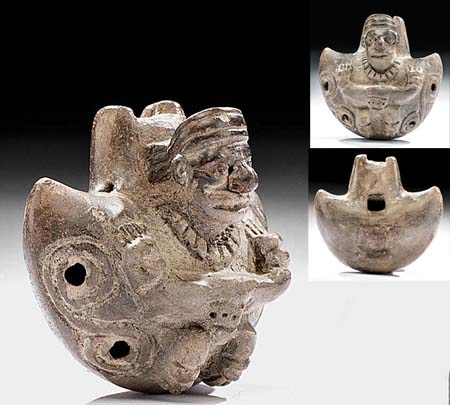
Owner: HWMC
Catalog#: 2LA-AEWF-1
Provenance: Leonard Kalina Collection, California, USA
Edge Blown Flutes
Columbia ‘Tairona' Ocarina
Columbia
Tairona Culture
Terra-cotta
ca. 1000 to 1500 CE
Height: 2.2 in; Width: 2.3 in
Aerophones – Wind Instruments Proper – Edge Blown Flutes
A Pre-Columbian hand-made brownware pottery ocarina from the Tairona (or Tayrona) culture, ca. 200 to 1600 CE, in the region of Sierra Nevada de Santa Marta in present-day Cesar, Magdalena and La Guajira Departments of Columbia. The Tairona were known for their expertise in crafting and metallurgy, especially goldsmithing. This pottery ocarina (ca. 1000 to 1500 CE) is crafted in a half-moon form with a protruding mouthpiece on top. The tumi-shaped body of the instrument features four petite tone holes that change the notes/pitches of the emitted sound, while incised lemniscate shapes (figure eight) surround a pair of tone holes on either side. Surmounting the ocarina is an elderly figure, perhaps a cacique (king/prince) or shaman (medicine man), with raised arms, a ‘beaded’ necklace, and a sash wrapped around his forehead.
The ocarina is a “vessel flute” that appears throughout the world but is especially central to music in South America’s Andean mountains. There are many variations, but generally it has a small open space that traps air, with a mouthpiece that enables a musician to blow into the enclosed space much the same as blowing into a whistle. Often there are several finger holes for the musician to open or close to change the notes/pitches. The role of the ocarina has not been fully explored or documented in Mesoamerica, but one theory is that they were used in helping the priest or shaman to communicate or cross over between the living world to the spirit world. Spanish colonists have also noted the use of special shrines for musical wind instruments and the playing of ocarina-like whistles and flutes to announce ritual dancing and chanting.
